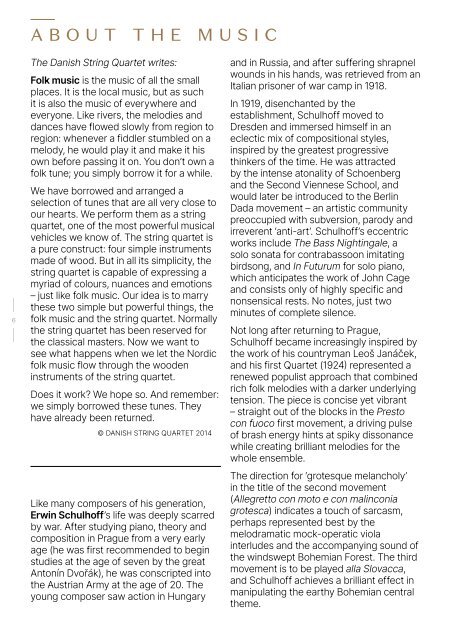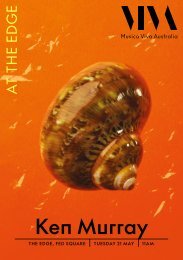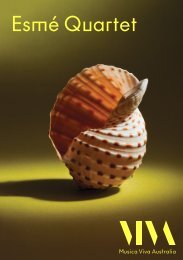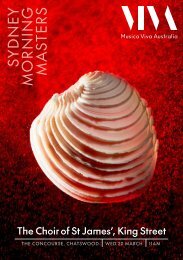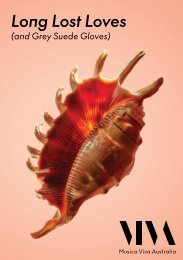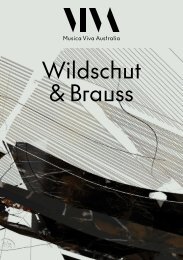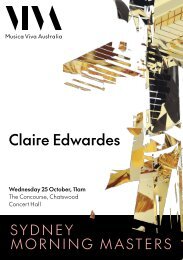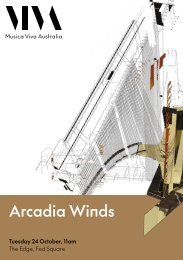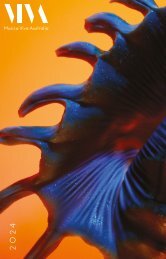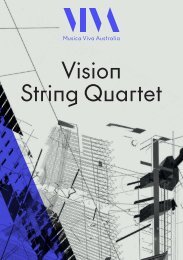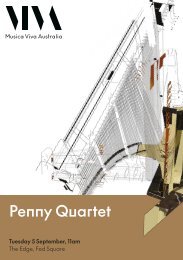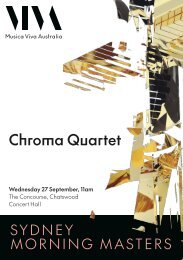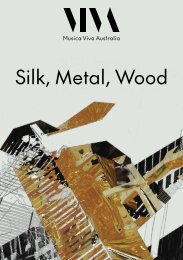Orava Quartet & Daniel De Borah Program Guide | March 2022
Create successful ePaper yourself
Turn your PDF publications into a flip-book with our unique Google optimized e-Paper software.
ABOUT THE MUSIC<br />
|<br />
6<br />
|<br />
The Danish String <strong>Quartet</strong> writes:<br />
Folk music is the music of all the small<br />
places. It is the local music, but as such<br />
it is also the music of everywhere and<br />
everyone. Like rivers, the melodies and<br />
dances have flowed slowly from region to<br />
region: whenever a fiddler stumbled on a<br />
melody, he would play it and make it his<br />
own before passing it on. You don’t own a<br />
folk tune; you simply borrow it for a while.<br />
We have borrowed and arranged a<br />
selection of tunes that are all very close to<br />
our hearts. We perform them as a string<br />
quartet, one of the most powerful musical<br />
vehicles we know of. The string quartet is<br />
a pure construct: four simple instruments<br />
made of wood. But in all its simplicity, the<br />
string quartet is capable of expressing a<br />
myriad of colours, nuances and emotions<br />
– just like folk music. Our idea is to marry<br />
these two simple but powerful things, the<br />
folk music and the string quartet. Normally<br />
the string quartet has been reserved for<br />
the classical masters. Now we want to<br />
see what happens when we let the Nordic<br />
folk music flow through the wooden<br />
instruments of the string quartet.<br />
Does it work? We hope so. And remember:<br />
we simply borrowed these tunes. They<br />
have already been returned.<br />
© DANISH STRING QUARTET 2014<br />
Like many composers of his generation,<br />
Erwin Schulhoff’s life was deeply scarred<br />
by war. After studying piano, theory and<br />
composition in Prague from a very early<br />
age (he was first recommended to begin<br />
studies at the age of seven by the great<br />
Antonín Dvořák), he was conscripted into<br />
the Austrian Army at the age of 20. The<br />
young composer saw action in Hungary<br />
and in Russia, and after suffering shrapnel<br />
wounds in his hands, was retrieved from an<br />
Italian prisoner of war camp in 1918.<br />
In 1919, disenchanted by the<br />
establishment, Schulhoff moved to<br />
Dresden and immersed himself in an<br />
eclectic mix of compositional styles,<br />
inspired by the greatest progressive<br />
thinkers of the time. He was attracted<br />
by the intense atonality of Schoenberg<br />
and the Second Viennese School, and<br />
would later be introduced to the Berlin<br />
Dada movement – an artistic community<br />
preoccupied with subversion, parody and<br />
irreverent ‘anti-art’. Schulhoff’s eccentric<br />
works include The Bass Nightingale, a<br />
solo sonata for contrabassoon imitating<br />
birdsong, and In Futurum for solo piano,<br />
which anticipates the work of John Cage<br />
and consists only of highly specific and<br />
nonsensical rests. No notes, just two<br />
minutes of complete silence.<br />
Not long after returning to Prague,<br />
Schulhoff became increasingly inspired by<br />
the work of his countryman Leoš Janáček,<br />
and his first <strong>Quartet</strong> (1924) represented a<br />
renewed populist approach that combined<br />
rich folk melodies with a darker underlying<br />
tension. The piece is concise yet vibrant<br />
– straight out of the blocks in the Presto<br />
con fuoco first movement, a driving pulse<br />
of brash energy hints at spiky dissonance<br />
while creating brilliant melodies for the<br />
whole ensemble.<br />
The direction for ‘grotesque melancholy’<br />
in the title of the second movement<br />
(Allegretto con moto e con malinconia<br />
grotesca) indicates a touch of sarcasm,<br />
perhaps represented best by the<br />
melodramatic mock-operatic viola<br />
interludes and the accompanying sound of<br />
the windswept Bohemian Forest. The third<br />
movement is to be played alla Slovacca,<br />
and Schulhoff achieves a brilliant effect in<br />
manipulating the earthy Bohemian central<br />
theme.


